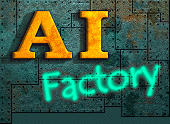When AI Factory entered the games industry in 2003, being a computer games programmer was not widely regarded as a highly professional career. The industry was considered somewhat junior compared to, say, the film industry, which at the time earned roughly three times the revenue. Declaring yourself a game developer lacked the prestige associated with professional programming roles in finance or engineering. If you rewind further to 1980, home computer gaming was just a small part of the toy industry.
Fast-forward from 2003 to today, and computer gaming has flipped the script, now generating approximately six times the revenue of the film industry, compared to just a third two decades ago.
However, there is an even more profoundly impactful way to evaluate the value of the computer gaming profession. The current acceleration in industry has been driven by the development of powerful AI tools through large language models (LLMs), such as ChatGPT. This advancement is expected to trigger the most rapid industrial transformation in human history, significantly improving productivity across a wide range of sectors. These are critical years.
It's fairly clear that this progress has, indirectly, been made possible by the gaming industry, not through general AI methods, but through the creation of powerful GPUs, which have been essential to the development of LLMs. The emergence of early powerful graphics cards from companies like 3DFX and NVIDIA would likely never have occurred without computer gaming. While CAD tools also benefited from these technologies, CAD represented only a tiny portion of the user base, with far fewer customers. It was gaming that drove the demand for this hardware.
Interestingly, it was later discovered that these GPUs could be repurposed for use in technical domains such as AI, something the original creators could never have foreseen. This shift represents a radical transformation in utility: from graphical rendering to AI computation. It's hard to find another example where a product's eventual use was so far removed from its original purpose. Even the creation of the World Wide Web by Tim Berners-Lee at CERN, which ultimately revolutionised commerce via e-commerce, doesn't represent as dramatic a pivot as the shift from GPU rendering to AI processing.
We can even draw a more finely grained connection between gaming and LLMs. In 1993, id Software released Doom, pioneering the real-time 3D gaming genre. At the time, this was limited by slow 2D video hardware relying on sprites and 2D texture maps with conventional video cards. It was obvious that such games would benefit from the then-unavailable advanced polygon rendering. The success of Doom established the genre and created a clear need for dedicated GPU hardware. id Software soon announced the more advanced Quake, which debuted in 1996, coinciding with the release of 3DFX’s first Voodoo 3D cards.
That marked the beginning. 3DFX was soon outpaced by NVIDIA’s TNT cards, and the company was ultimately acquired by NVIDIA in 2000. The die had been cast.
In conclusion, one could argue that the rise of modern LLM technology was indirectly catalysed by the release of Doom.
AI Factory has primarily focused on improving and refining our existing line of products, which remains the most efficient way to sustain our business. This work is demanding, especially since our main platform, Google Play, is continually evolving with updates from Google and the ad networks. For example, the transition from Android 14 to 15 has required substantial revisions to our apps. The ad networks are also in constant flux, requiring SDK updates and ongoing operational management.
Our apps aren’t entirely static. We’ve made significant improvements to time controls in our online chess product, and a major update is on the horizon once the online play release is finalised.
We also have a new product in development, our most ambitious yet for Google Play. It’s currently being developed as a Windows console app, allowing us to refine gameplay before porting it to Google Play. It may eventually launch on iOS and Steam as well. The image below shows some placeholder artwork offering a small glimpse of the product, without revealing gameplay details.

The past year has brought other notable events for AI Factory. One highlight was the final World Computer Chess Championship, hosted by the ICGA (International Computer Games Association) during the 27th ECAI (European Conference on Artificial Intelligence) in Santiago de Compostela, Spain (October 19–24, 2024). The first championship took place in 1974 in Stockholm, and we have had connections with participants since 1977. Our first article covers this historic event.

Of course, we also attended GDC in San Francisco again, which included important meetings with our business partners. The event continues to be a source of inspiration and insight into the direction of the games industry. With around 30,000 attendees, it offers an endless stream of stimulating conversations and high-quality presentations. It’s an invaluable source of ideas and motivation!

In summary, AI Factory remains in excellent health. We have been impacted somewhat by the U.S. election, which caused a roughly 10% drop in the value of the dollar and thus affected our revenue. However, we are in a strong position, and this has not presented a serious problem. Now in our third decade, we are naturally reflecting on how our direction might evolve as we, too, grow older.
August 2025
